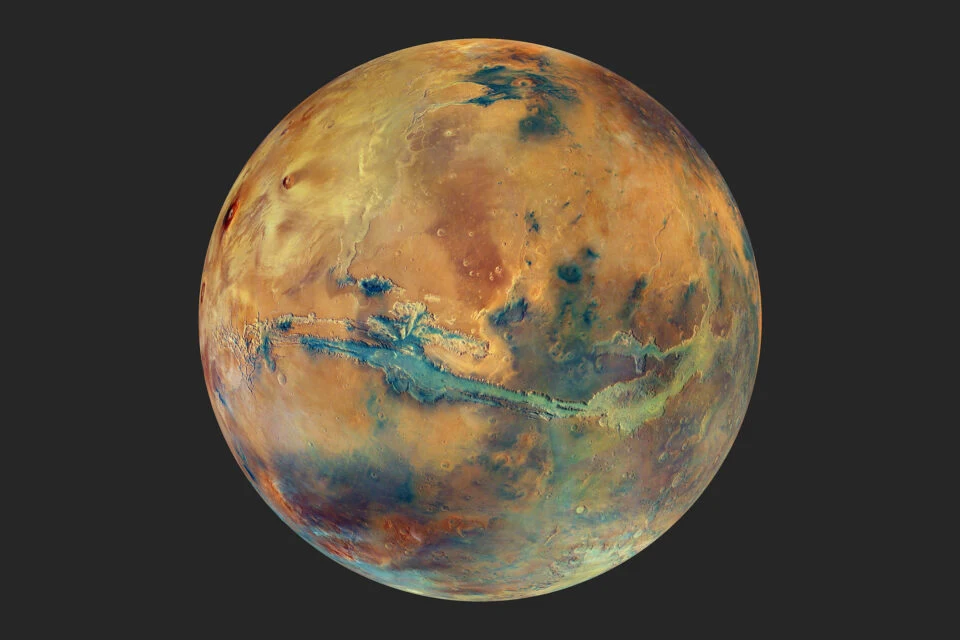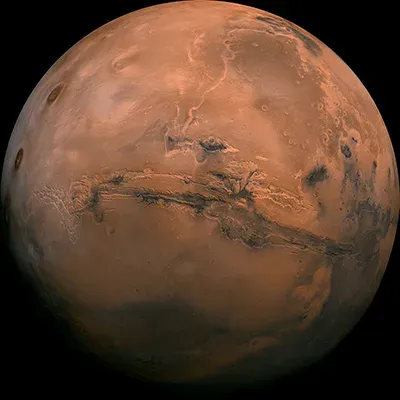Mars, frequently alluded to as the "Red Planet," has spellbound human interest for a long time. From its particular ruddy tint to its true capacity as a future objective for investigation and colonization, Mars stays a point of convergence of logical examination and investigation.
Mars is the fourth planet from the Sun in our nearby planet group and the second littlest planet. Named after the Roman lord of war, it is in many cases portrayed by its rosy appearance, credited to press oxide pervasive on its surface.
With a breadth of roughly 6,779 kilometers, Mars brags a rich history investigation, with various shuttles and meanderers shipped off to concentrate on its surface and environment.
In this article, we will dive into the complexities of this mysterious planet, investigating its actual qualities, surface highlights, moons, investigation attempts, potential forever, difficulties, and the importance of space investigation.
Here Are The 50 Amazing And Unique Facts About Planet Mars
Mars is known as the "Red Planet" because of its reddish-brown surface, which is rusty and iron-rich.
Between Earth and Jupiter, Mars is the fourth planet in our planetary group from the Sun.
Phobos and Deimos, two of Mars' minor moons, are awry and may have been caught in space rocks.
Olympus Mons, the greatest well of lava in the nearby planet group, is situated on Mars. It has a measurement of around 370 miles (600 km) and a transcending level of 13.6 miles (22 km).
The longest gorge framework in the planetary group, Valles Marineris, is situated on Mars and ranges more than 2,500 miles (4,000 km).
Also Read: 20 Amazing Wild Facts About the Color Red
A day on Mars, or "sol," endures generally 24.6 hours, which is just 40 minutes longer than a day on The planet.
Mars has a slender air that is comprised of carbon dioxide, with limited quantities of argon and nitrogen. Mars' pneumatic force is just 0.6% that of Earth.
Mars is a freezing planet, with normal temperatures of about - 80 degrees Fahrenheit (- 62 degrees Celsius).
The polar ice covers of Mars are made out of dry ice, frozen carbon dioxide, and water.
As a result of its hub slant, Mars has various seasons, very much like Earth, but because of its more extended circle, these seasons are almost two times as long.
Also Read: Exploring Teeniest Tiny Sculptures – Mini Art Marvels
Mars is notable for its months-long, extensive residue storms. The planet overall might be overwhelmed by these tempests, which influence surface permeability.
Notwithstanding Olympus Mons, Mars is home to Arsia Mons, the most elevated mountain in the nearby planet group.
Mars' trademark red tone is brought about by the iron oxide or rust, that covers a lot of its surface.
Methane is intermittently let out of Mars, and researchers are as yet sorting out whether or not this is brought about by microbial life or by topographical cycles.
For ages, Mars has caught the consideration of individuals, with various societies interfacing it to ripeness and war divine beings.
Also Read: 15 Unveiling Facts About Mona Lisa: The Iconic Enigma
Galileo Galilei spread the word about the main telescope perception of Mars in 1610.
NASA has been effective in sending different meanders, like Sojourner, Soul, Opportunity, Interest, and Steadiness, to explore Mars.
In 2021, the Determination Wanderer landed on Mars with the mission of searching for proof of terminated microorganisms and social event tests for an expected return to Earth.
Water fumes once in a while structure, slight mists in Mars' air, which brings about dazzling yet fragile cloud shapes.
Dust has fallen angels are far and wide on Mars and should be visible clearing around the surface. They are practically identical to cyclones on Earth, however shaped of residue.
Also Read: 15 Facts about how powerful is the color white?
Albeit a lot of Mars is dry, there is proof that recommends fluid water might exist underneath the surface, which could prompt the development of microbial life.
Due to its shortfall of structural action, Mars has a bigger convergence of iron shooting stars than the Earth.
Like Earth, Mars contains polar vortices, but because of its more drawn-out circle, the force and situation of these highlights change all through the Martian year.
Aside from meanders, a few orbiters from various space associations have been noticing Mars from a circle, offering significant bits of knowledge about its temperature and topography.
Timekeeping on Mars is troublesome for a day there varies from a Natural day. The Martian day is separated into "souls," and mission regulators run their tasks utilizing a Mars timekeeping framework.
Also Read: 15 Shady Facts About The Color Black / Why is black a powerful color?
Certain areas of Mars show attributes that demonstrate the planet might have once had earthlike conditions helpful for fluid water.
Marsquakes are seismic occasions likened to quakes that happen on Mars. Contrasted with those on The planet, they are less continuous and extreme.
The breadth of Phobos, the greater moon of Mars, is multiple times that of Deimos, the more modest moon.
There are many safeguards volcanoes and wide magma fields among Mars' numerous volcanic elements.
Ice and snowfall are normal on Mars, particularly in the higher scopes and elevations.
Also Raed: 50 Mercury Facts That Will Change How You See Our Solar System
NASA's Sailor 4 space apparatus made the first fruitful flyby of Mars in 1965, bringing about the principal very close photographs of the planet.
Underground caverns on Mars could give more steady circumstances that could uphold microbial life.
Sun-based fueled missions are tested by Martian residue storms since dust gathers on sun-powered chargers and brings down their adequacy.
Yet again as per a few logical speculations, Mars looked like Earth and could have had fluid water on its surface notwithstanding a tantamount climate.
A Mars Test Return mission is being arranged, in which tests assembled by the Diligence wanderer will be gotten back to Earth for to-bottom assessment.
Also Read: Unlocking Antarctica's Secrets: 50 Penguin Facts That Will Blow Your Mind
Hellas Planitia, the planet's biggest effect bowl, has a boundary of 1,100 miles (1,800 km) and a profundity of more than 6 miles (10 km).
NASA's Viking 1 orbiter snapped a photo of a Martian plateau in 1976 that, when seen from a specific point, seems to be a human face. It was named the "Face on Mars."
Like Earth, Mars has a hub slant, but because of its more prominent inconstancy, the planet goes through additional sensational occasional varieties.
Mars doesn't have a worldwide attractive field, even though there may be limited attractive fields there, which could bring about auroras in certain areas.
The hub slant of the planet influences the relocation of Mars' polar ice covers, which extend and contract in light of the changing of the seasons.
Also Read: Eagle-Eye Insights: 50 Incredible Facts That Redefine Visual Perception
Various scenes, like extensive deserts, stony landscapes, and memorable waterway valleys, should be visible on Mars' surface.
Mars' land highlights are different in its northern and southern sides of the equator, with the previous having more holes and high countries and the last option being similarly smoother.
The Mars investigation has been supported by various countries and space offices across the globe, including NASA (USA), ESA (Europe), and ISRO (India).
A couple of private organizations and space bunches are effectively creating systems for human colonization of Mars, envisioning when individuals would have the option to live and work there.
Mars' environment can be enormously impacted by huge residue storms, which can adjust the planet's temperature and climatic circumstances.
Also Read: The Ghostly Guardians: 50 Unbelievable Facts About Ghost Bird Potoo!
The deficiency of Mars' overall attractive field billions of years prior could have sped up the planet's environmental diminishing.
The greater moon Phobos is gradually turning internally toward Mars. In the far future, it is normal to either slam into Mars or split separated into a ring.
Mars' lake bowls and old riverbeds give proof that fluid water previously streamed to the world's surface.
Mars is much of the time depicted as a secretive and maybe possessed planet, making it a well-known theme in writing, film, and music.
Innovation improvement, logical headway, and the human soul of investigating universes past our own are undeniably impacted by the investigation of Mars.
Also Read: The Ocean's Enigma: 50 Fascinating Secrets of the Octopus Revealed!
Posted By F A C T O L O G Y
"Factology " is a Fact Blog. Here you can find all kinds of facts and blogging-related content My name is Mihir Patel and I am a passionate blogger. Blogging has been my creative outlet for several years now, and I love the freedom it gives me to express myself and share my ideas with the world. Through my blog, I write about a wide range of topics that interest me, including technology, science, and space.
Tags: Planet Facts







